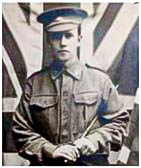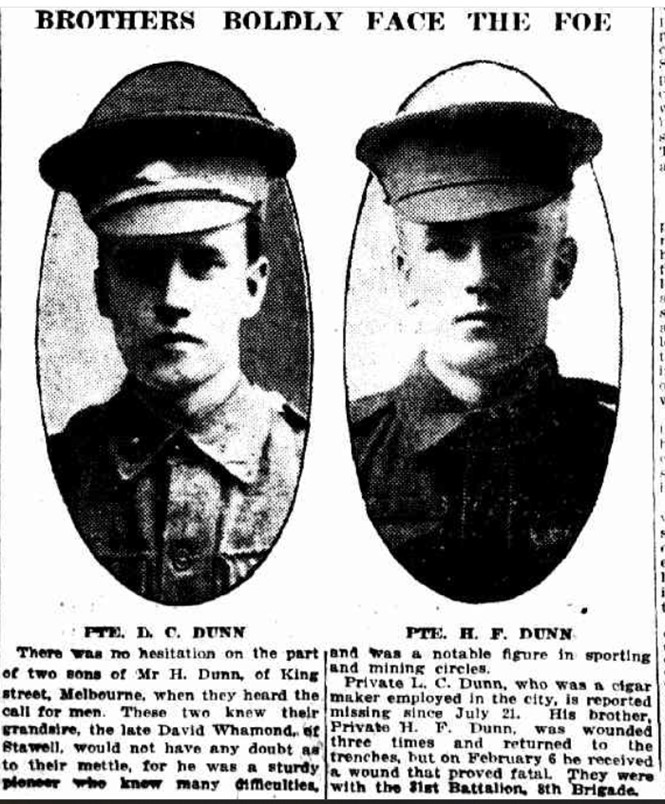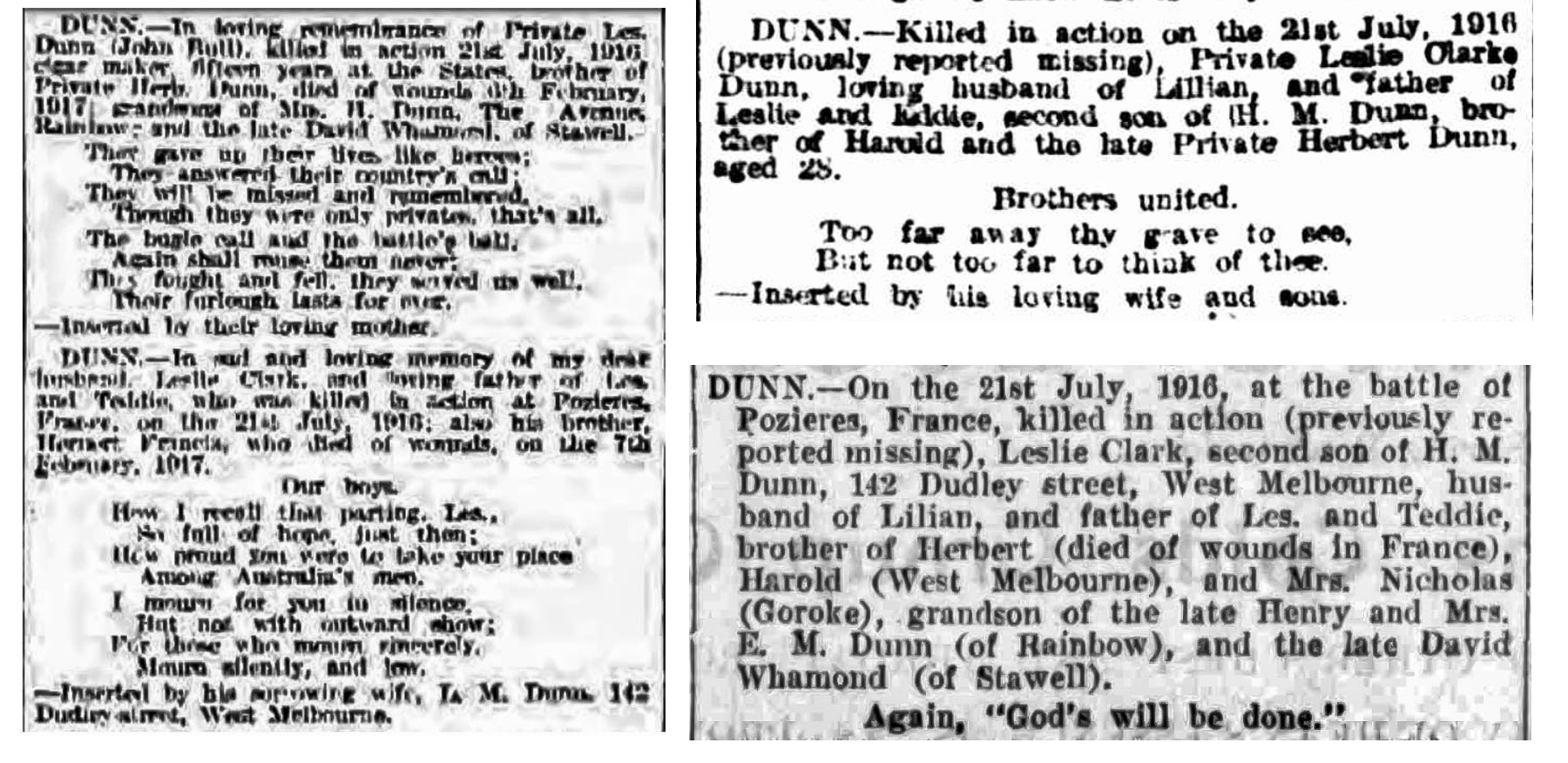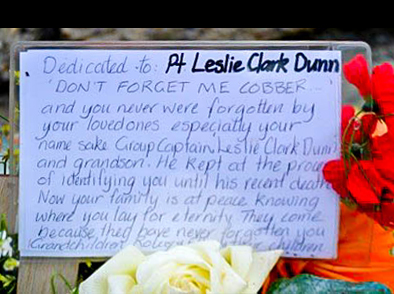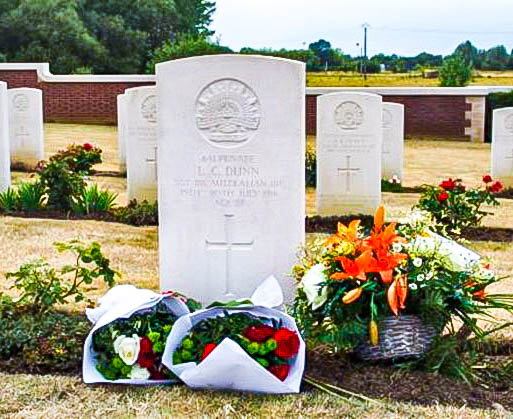Leslie Clark DUNN
Eyes blue, Hair brown, Complexion fresh
Leslie Dunn - “Four Generations of Dunn Soldiers”
Early Life
David Leslie Clark (Clarke) Dunn was born in 1888 at Richmond, Victoria. He was the second of Henry Mark and Catherine’s (nee Whammond) four children – Harold, Les, Mabel and Herbert. Les’ childhood would have been a turbulent one, as his parents moved a number of times in both western Victora and in the Melbourne area and then divorced in 1899. Catherine moved back to her father’s home in Stawell. Later, Mark lived with Les and his family for many years, both before and after the War.
Les finished his schooling in his early teens and then worked for the States Tobacco Company, first under a four-year apprenticeship and then as a cigar maker. He had been with them a total of 15 years when he enlisted. Les married Lillian Stevens in 1909 and they had two sons, David Henry Clarke (1910) and Edward Mark (1912).
They were living at 142 Dudley St, West Melbourne when Les enlisted. Les’s younger brother Herbert (1729) also served, in Gallipoli and the Western Front.
Off to War
Even though he had two young sons, the 27-year-old Les felt the Call to War and enlisted on 12 July 1915 at Melbourne, Victoria. He was assigned to the 31st Battalion, C Company and did his military training at the Broadmeadows Camp. Herbert had enlisted in November 1914. The 31st Battalion was formed with two companies from Queensland and two companies from Victoria.
All were joined in early October at the Victorian Broadmeadows camp. Before sailing from Melbourne on 9 November aboard the troopship Wandilla , the 991 soldiers of the 31st had been on parade in Melbourne in front of a good crowd.
The Minister for Defence, H.F. Pearce said:
‘I do not think I have ever seen a finer body of men.’
The Wandilla docked at Port Suez exactly four weeks after leaving Melbourne. The soldiers were first sent to Serapeum to continue their training and to guard the Suez Canal. Near the end of February, they moved to the large camp at Tel el Kebir. The 60 km trip must have been unpleasant, as it was reported that they were moved in ‘dirty horse trucks’.
Source AWM4 23/48/7, 31st Battalion War Diaries, Feb 1916, page 5
The next move was at the end of March, back to the Suez Canal at the Ferry Post and Duntroon Camps and then finally to Moascar at the end of May. The months passed in training and sightseeing, but by the time the 31st Battalion was transferred to France, the men were all heartily sick of Egypt. Private Les Smith’s (934) letter home pretty well sums it up.
The Western Front – Fromelles
On 15 June, the 31st Battalion began to make their way to the Western Front, first by train from Moascar to Alexandria and Les’ C Company went on the troopship Manitou to Marseilles. After disembarking on 23 June, they boarded trains to Steenbeque and marched to their camp at Morbecque, which is 35 km from Fromelles, arriving on 26 June.
The battalion strength was 1019 soldiers. Training continued, but now with how to handle poisonous gas included in their regimen. They began their move towards Fromelles on 8 July and by 11 July Les was into the trenches for the first time.
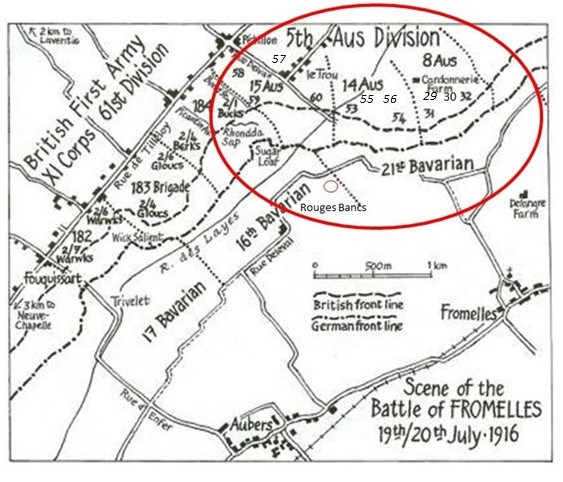
The original attack was planned for the 17th, but bad weather caused it to be postponed. On the 19th they were back into the trenches and in position at 4.00 PM.
“Just prior to launching the attack, the enemy bombardment was hellish, and it seemed as if they knew accurately the time set.”
The assault began at 5.58 PM and they went forward in four waves, Les’s C Company and A Company in the first two waves and B and D Companies in the 3rd and 4th waves. There were machine guns emplacements to their left and directly ahead at Delrangre Farm and there was heavy artillery fire in No-Man’s-Land. The pre-battle bombardment did have a big impact and by 6.30 PM the Aussies were in control of the German’s 1st line system (Trench B in the diagram below), which was described as ‘practically a ditch with from 1 to 2 feet of mud and slush at the bottom’.
Source AWM4 23/49/12, 32nd Battalion War Diaries, July 1916, page 11.

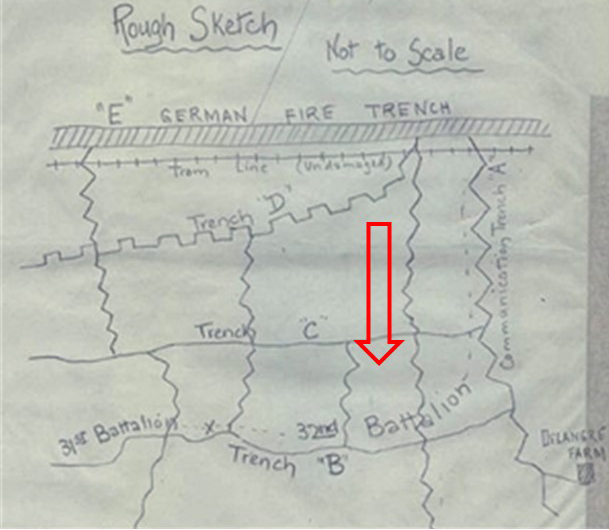
Unfortunately, with the speed and success of their attack, they were also under ‘friendly’ artillery fire and it was during this time that Les was killed. One of Les’s mates, Albert Beck (1119) C Company, stated:
“I last saw Dunn at 7.30 p.m. on 19 July, 500 to 700 yds. behind the last line of German trenches at Fromelles. We got on too far and came into the barrage of our own guns. We had to fall back and Dunn was not seen to come back with us. I have already sent these details to his wife in Melbourne. (note - statement taken 29 January 1917)”
By 8.30 PM the Australians’ left flank had come under heavy bombardment with high explosives and shrapnel. Return bombardment support was provided and the 32nd, who also had the job of holding the flank to the left of the 31st, were told that ‘the trenches were to be held at all costs’.
Source AWM4 23/49/12, 32nd Battalion War Diaries, July 1916, page 12.
Fighting continued through the night. At 4.00 AM the Germans began an attack from the Australian’s left flank, bombing and advancing into Trench A (map). Given the Australian advances that had been made earlier, portions of the rear Trench E had been left almost empty, which then enabled the Germans to be in a position to surround the soldiers. At 5.30 AM the Germans attacked from both flanks in force and with bombing parties. Having only a few grenades left themselves, the only resistance the 31st could offer was with rifles.
“The enemy swarmed in and the retirement across No Mans’ Land resembled a shambles, the enemy artillery and machine guns doing deadly damage.”
The 31st were out of the trenches by the end of the day on the 20th. From the 1019 soldiers who left Egypt, the initial impact was assessed as 77 soldiers were killed or died from wounds, 414 were wounded and 85 were missing. To get some perspective of the battle, when Charles Bean, Australia’s official war historian, attended the battlefield two and half years later , he observed a large amount of bones, torn uniforms and Australian kit still on the battlefield.
The ultimate total was that 161 soldiers were either killed or died from wounds and of this total 82 were missing/unidentified. The bravery of the soldiers of the 31st was well recognised by their own Battalion commanders.
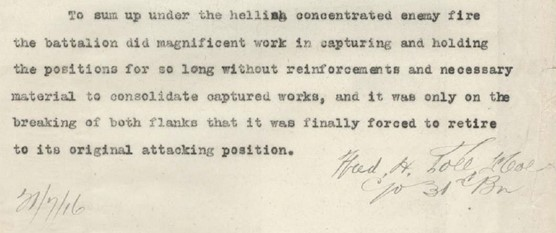
The Long Wait After the Battle
Les was among the ‘missing’ and Lillian was advised of this. However, given the devastation of the battle, it is not surprising that any further confirming details from the Army were hard to come by. At least his mate Albert had taken action to provide Lillian with something concrete, even if it was unwelcome news. As Les had been killed in the advanced areas, his body had been found by the Germans.
His name appeared on a German Death List dated 4 November 1916 - ‘in Gegend Fromelles gefallen’. His ID tags were returned by the Germans and the Army sent them to Lillian in June 1917.

While there appeared to be information available about Les, when Lillian wrote to the Army in late December she stated that she had not heard any further word from them since July.
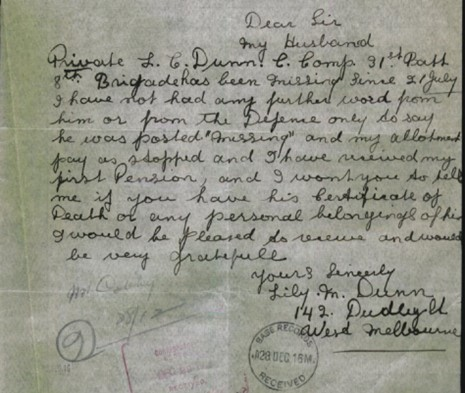
They did reply, but still advised there was no further news. A formal ‘enquiry in the field’ was held in March 1917 and Les was confirmed as having been Killed in Action. Just a month earlier, the family also learned that Les’s brother Herbert had been killed on 5 February 1917 during the Stormy Trench attack at Gueudecourt, 80 km south of Fromelles.
Les and Herbert were clearly missed by their families.
Les was awarded a 1914/15 Star Medal, a British War Medal and a Victory Medal as well as a Memorial Plaque and a Memorial Scroll. Curiously, while he was clearly killed in the battle on the 19/20th, the certification of his death states he was killed on the 21st. As a result, he was not commemorated at the VC Corner Memorial, but at Villers-Bretonneux. The date of his death was a clerical mistake that was made for a number of soldiers from the 31st, C Company and this was not rectified for over 100 years.
Also, there is an undated, handwritten note in his AIF file that states he was buried. However, it only gives a very general map reference which is several kilometers from the site of the battle and there are similar notations for many 31st Battalion, C Company soldiers.

He remained missing. Other soldiers with a similar note on their file include John Joseph Curran and Reginald George Denton.
Don’t Forget Me Cobber
Missing, Killed in Action, no known grave – a gallant sacrifice for ‘King and Country’.
Les’ commitment was obviously passed on through his family – four generations of Australian soldiers. His eldest son David joined the Royal Australian Air Force and served from 1939 – 1948; David’s son Leslie served in the RAAF as a pilot for 33 years; and Leslie’s son Chris spent 15 years as a RAAF pilot. Clearly not forgotten.
Found at Last
In 2008, a mass grave dug by the Germans was found at Fromelles. It contained the remains of 250 Australian soldiers who were recovered after the battle. The grave was in the vicinity where the 31st had been fighting. With this discovery, an extensive project was undertaken to identify these 250 soldiers by DNA matching from family members. Les’ great grandson Chris had been at Fromelles with his dad for the dedication ceremony of the new cemetery in 2010, which included the identification of 96 soldiers.
"It was actually quite emotional when we were there. To walk through afterwards and see all of the unknown soldiers' headstones, it was quite eye opening."
Les’ grandsons Leslie and Roley provided DNA samples early on, but years passed with no news and they largely gave up hope their grandfather could be identified. The identification efforts were continuing, however, and Les Dunn was finally identified in 2019…103 years after the battle.
Sadly, Les’ grandson Leslie died shortly before the announcement of the discovery was made in March 2019. Leslie’s grandson Roley noted:
"It is bittersweet that, yes, we have got closure on it but it's too late for him to hear about it.”
Roley went on to say:
“It's been a part of our family's almost folklore that, yes, our grandfather was killed over there. He was only young, he left young children behind and a young widow and 'we don't know where he is'.
We basically had no real closure. He was just this mystical figure that we knew very little about.
The fact that they've now made an ID and that he will have a named grave gives a wonderful sense of closure to the whole thing”
Chris was particularly struck by his great-grandmother's heart-breaking requests in Les’ War records for information about her missing husband and later his death certificate and will.
"She's saying - 'I've got two young sons. It's hard to settle affairs if I don't know that he's actually been killed.' It's quite sad."
Chris is proud of his family's four generations of military service, but lamented the ‘utter waste of life’ at Fromelles for little or no strategic gain. ‘It really was just a complete tragedy.’
Prior to attending Les’ interment ceremony, Chris said he expected it will be both emotional and comforting, knowing there is now a focal point for grieving.
”I think it's important that we continue to recognise those who paid the ultimate sacrifice over there, a long way from home."
The Fromelles Association would love to hear from you

Contacts
(Contact: carla@fromelles.info or geoffrey@fromelles.info).
(Contact: army.uwc@defence.gov.au or phone 1800 019 090).
Donations
If you are able, please contribute to the upkeep of this resource.
(Contact: bill@fromelles.info ).
